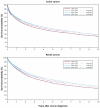Survival of patients with colon and rectal cancer in central and northern Denmark, 1998-2009
- PMID: 21814467
- PMCID: PMC3144775
- DOI: 10.2147/CLEP.S20617
Survival of patients with colon and rectal cancer in central and northern Denmark, 1998-2009
Abstract
Objective: The prognosis for colon and rectal cancer has improved in Denmark over the past decades but is still poor compared with that in our neighboring countries. We conducted this population-based study to monitor recent trends in colon and rectal cancer survival in the central and northern regions of Denmark.
Material and methods: Using the Danish National Registry of Patients, we identified 9412 patients with an incident diagnosis of colon cancer and 5685 patients diagnosed with rectal cancer between 1998 and 2009. We determined survival, and used Cox proportional hazard regression analysis to compare mortality over time, adjusting for age and gender. Among surgically treated patients, we computed 30-day mortality and corresponding mortality rate ratios (MRRs).
Results: The annual numbers of colon and rectal cancer increased from 1998 through 2009. For colon cancer, 1-year survival improved from 65% to 70%, and 5-year survival improved from 37% to 43%. For rectal cancer, 1-year survival improved from 73% to 78%, and 5-year survival improved from 39% to 47%. Men aged 80+ showed most pronounced improvements. The 1- and 5-year adjusted MRRs decreased: for colon cancer 0.83 (95% confidence interval CI: 0.76-0.92) and 0.84 (95% CI: 0.78-0.90) respectively; for rectal cancer 0.79 (95% CI: 0.68-0.91) and 0.81 (95% CI: 0.73-0.89) respectively. The 30-day postoperative mortality after resection also declined over the study period. Compared with 1998-2000 the 30-day MRRs in 2007-2009 were 0.68 (95% CI: 0.53-0.87) for colon cancer and 0.59 (95% CI: 0.37-0.96) for rectal cancer.
Conclusion: The survival after colon and rectal cancer has improved in central and northern Denmark during the 1998-2009 period, as well as the 30-day postoperative mortality.
Keywords: colorectal cancer; epidemiology; neoplasms; survival.
Figures
References
-
- World Health Organization. Health statistics and health information systems. 2011. [Accessed February 23, 2011]. Available from: http://www.who.int/healthinfo/global_burden_disease/estimates_regional/e....
-
- Jemal A, Siegel R, Xu J, Ward E. Cancer statistics, 2010. CA Cancer J Clin. 2010;60(5):277–300. - PubMed
-
- Sundhedsstyrelsen. Cancerregisteret 2009. Updated 2010. [Accessed February 23, 2011]. Available from: http://www.sst.dk/Udgivelser/2010/Cancerregisteret%202009.aspx.
-
- Klinisk Epidemiologisk Afdeling Aarhus. Kort- og langtidsoverlevelse efter hospitalsbehandlet kræft, Region Midtjylland og Region Nordjylland 1998–2009. 1st ed. Aarhus Universitet; 2010.
-
- Storm HH, Engholm G, Hakulinen T, et al. Survival of patients diagnosed with cancer in the Nordic countries up to 1999–2003 followed to the end of 2006. A critical overview of the results. Acta Oncol. 2010;49(5):532–544. - PubMed
LinkOut - more resources
Full Text Sources
Medical
Miscellaneous


